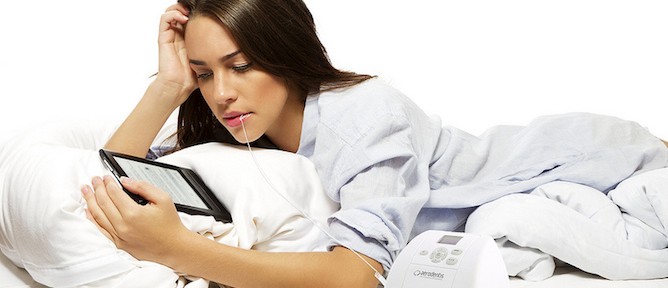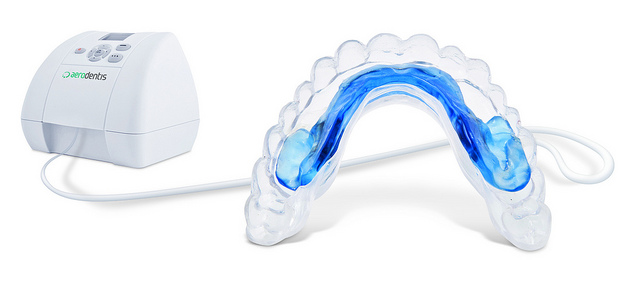Jerusalem-based Aerodentis offers a
high-tech alternative to clunky orthodontic braces, and you only wear it
while you’re sleeping.

The device is used for 10 hours, while resting and sleeping.
Israeli orthodontist and dentofacial orthopedic specialist Dr. Orit Nadav determined to find a way to deliver desired results without all the hardware. She and a team of 12 orthodontists, engineers, industrial designers and dental technicians spent eight years developing Aerodentis, a groundbreaking, high-tech alternative to braces for patients of any age.
Aerodentis earned the European CE Mark and has been on the market since January 2013. About 100 units have so far been sold to dental professionals in Israel, Switzerland and Spain. US Food and Drug Administration approval is expected within two years.
Here’s how it works: The patient places the customized thermoplastic mold over the teeth, connects it to a portable bedside console and pushes a button to activate the unit, which is powered by a rechargeable battery. The console contains an air pump, pressure sensor and secure digital (SD) smart card programmed with the individual’s treatment regimen.

The control console customizes treatment and records usage.
Following the program, the control unit applies pulsating pneumatic force to reposition teeth gradually and comfortably via tiny silicon balloons inside the mouthpiece. The SD card records usage, so that the dental professional can track progress and compliance when the patient visits every few months, or adjust the treatment plan.
Mimics body’s natural rhythm
“Orit understood from her research with orthopedists that the most efficient force is pulsating, rather than continuous,” explains Dror OrthoDesign Chief Executive Officer Michael Nadav, Orit’s husband.
“In nature, everything is pulsating. The heart is a pulsating, not a constant, force. By mimicking the body’s natural rhythm, our device facilitates better blood circulation in the periodontal tissue between the root and jawbone, and prevents complications involved in constant pressure, such as infections and pain. And we need less time to move the teeth.”
Nadav brought his expertise in electronics and product development to the medical device company he and his wife founded within the BioJerusalem hub to design, develop and manufacture pioneering orthodontic solutions. He showed ISRAEL21c around the Dror OrthoDesign office in the Har Hotzvim Industrial Park in northern Jerusalem.
Every stage of the patented process uses cutting-edge technology, from the computer-assisted design (CAD) imaging software used to customize each appliance to the dental professional’s specifications, to the three-dimensional printer that spits it out (pardon the pun).
What orthodontists say
Prof. Chung H. Kau, chairman of the department of orthodontics at the University of Alabama at Birmingham’s school of dentistry, is now starting the first US pilot trial with Aerodentis and hopes to gain FDA clearance to do a full clinical trial.
“My unit here is interested in new technologies than can alter the landscape for orthodontia, finding ways to shorten the long treatment process,” Kau tells ISRAEL21c. “Aerodentis struck me as fascinating because it is totally unrelated to the system we currently use. It has the ability to control the amount of force used, and the treatment is dictated by the patient. The device is novel and at this time does only small movements, not major movements, but I think it’s exciting.”
Wearing an appliance only at night isn’t just a cosmetic and comfort advantage over braces. Aerodentis users don’t have to worry about mouth abrasions from wire, don’t have to avoid chewing gum and other sticky foods, and can clean their teeth easily and thoroughly.
Dr. Moshe Davidovitch of Tel Aviv University’s school of dentistry says Aerodentis is a welcome solution for patients who are motivated enough to wear the appliance for the requisite 10 hours per day.
Davidovitch, a US-trained orthodontist who returned to Israel following a fellowship at Harvard University, used Aerodentis to straighten some of his own teeth, and recommends it for appropriate patients. He tells ISRAEL21c that Aerodentis can straighten front teeth in the upper and lower jaw, but cannot correct the bite. About half of all orthodontic patients do not need bite correction.
“You can’t use one appliance to fix every problem that exists. As long as you’re selective, you can achieve ideal success,” Davidovitch says. “The advantage of Aerodentis is that it uses very light forces in moving teeth, which is in line with the modern philosophy of orthodontics. It is biologically healthier and nicer for patients because nothing is bonded to the teeth.”
Dror OrthoDesign is a privately held company chaired by Chaim Hurvitz, CEO of CHealth, a private venture capital firm.
For more information, see http://www.aerodentis.com.
No comments:
Post a Comment